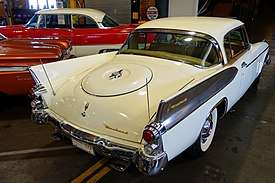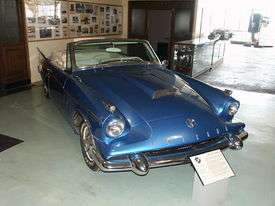Packard Hawk
The Packard Hawk is a model of automobile. It was the sportiest of the four Packard-badged Studebakers produced in 1958, the final year of Packard production.
| Packard Hawk | |
|---|---|
.jpg) | |
| Overview | |
| Manufacturer | Packard (Studebaker-Packard) |
| Model years | 1958 |
| Assembly | South Bend, Indiana, United States |
| Body and chassis | |
| Body style | 2-door hardtop |
| Layout | Front-engine, rear-wheel-drive |
| Related | |
| Powertrain | |
| Engine | 289 cu in (4.7 L) V8 |
| Transmission | 3-speed Flightomatic automatic |
| Dimensions | |
| Wheelbase | 120.5 in (3,061 mm) |
| Length | 205.2 in (5,212 mm) |
| Width | 71.3 in (1,811 mm) |
| Height | 54.6 in (1,387 mm) |
| Curb weight | 3,470 lb (1,574 kg) |
History and description
The Packard Plant in Detroit, Michigan had been leased to Curtiss-Wright (and would be soon sold to them), and Packard models in this dying-gasp year were all rebadged and retrimmed Studebaker products. The 1958 Packard Hawk was essentially a Studebaker Golden Hawk 400 with a fiberglass front end and modified deck lid.
Instead of the Studebaker Hawk's upright Mercedes-style grille, the Packard Hawk had a wide, low opening just above the front bumper and covering the whole width of the car. Above this, a smoothly sloping nose, and hood—reminiscent of the 1953 Studebakers, but with a bulge as on the Golden Hawk—accommodating the engine's McCulloch supercharger that gave the Studebaker 289 in³ (4.7 L) V8 a total of 275 bhp (205 kW). At the rear, the sides of the fins were coated in metallized PET film, giving them a shiny metallic gold appearance. A fake spare-tire bulge adorned the 1953-style Studebaker deck lid. PACKARD appeared across the nose, with a gold Packard emblem in script—along with a Hawk badge—on the trunk lid and fins.
The interior was full leather, with full instrumentation in an engine-turned dash. As on early aircraft and custom boats, padded armrests were mounted outside the windows, a rare touch.
The styling was definitely controversial, often described as 'vacuum-cleaner' or 'catfish' by detractors. The styling has come to be appreciated more today than in its debut. Only 588 were sold, with Packard's impending demise a likely contributing factor. Most were equipped with the Borg-Warner three-speed automatic transmission. Approximately 28 were produced with the B-W T85 3-speed w/overdrive manual transmission. Studebaker-Packard was the first manufacturer to popularize the limited slip differential, which they termed Twin-Traction. Most Packard Hawks came with TT. It was certainly the fastest Packard ever sold, since it shared the majority of its components with Studebaker's Golden Hawk. The price was $3995, about $700 higher than the Studebaker model, but with a more luxurious interior. Electric window-lifts and power seats were optional extras.
Its rarity and status as the best-regarded of the 'Packardbaker' final-year cars have made the Packard Hawk quite collectible. Values are roughly double those of the equivalent Studebaker, although they are still low by comparison with Corvettes and Thunderbirds. Because a Studebaker drivetrain was used, mechanical parts are more readily available, although body and trim parts are more difficult-to-impossible to find. While it is a unique car, current restoration costs almost always exceed the selling price.
Specifications
- Engine

- Type: Cast iron 90° V8, Silver Light dish-type pistons
- Displacement: 289 cubic inches
- Bore X stroke: 3.56 X 3.63 inches
- Compression ratio: 7.5:1
- Power @ rpm: 275 hp (205 kW) @ 4,800 rpm
- Torque @ rpm: 333 lb⋅ft (451 N⋅m) @ 3,200 rpm
- Valvetrain: In-head valves, solid lifters
- Main bearings: 5
- Ignition: Delco-Remy breaker-point
- Fuel system: 2-bbl Stromberg 380475 downdraft carburetor, McCulloch supercharger, 5 psi (34 kPa) max
- Lubrication system: Full-pressure, gear-driven
- Electrical system: 12-volt, 30 amperes
- Exhaust system: Cast iron, dual exhaust
- Transmission
- Type: Borg-Warner Flightomatic automatic
- Ratios
- 1st: 2.40:1
- 2nd: 1.47:1
- 3rd: 1.0:1
- Reverse: 2.0:1
- Differential
- Type: Semi-floating hypoid, Twin-Traction Spicer-Thornton limited slip
- Ratio: 3.31:1
- Steering
- Type: Power assist, Saginaw recirculating ball
- Ratio: 19.2:1
- Turns, lock-to-lock: 4.5
- Turning circle: 41 ft (12 m)
- Brakes
- Type: Four wheel, power-assist Wagner hydraulic
- Front: Cast-iron finned drum, 11 X 2.5 in
- Rear: Cast-iron drum, 10 X 2 in
- Swept area: 172.8 sq in
- Chassis & Body

- Construction: All-steel, box section, double-drop side rails, 5 crossmembers
- Body style: Two-door, five passenger hardtop, soft top prototype
- Layout: Front engine, rear-wheel drive
- Suspension
- Front: Individual unequal-length upper and lower control arms, coil springs, hydraulic shocks, anti-sway bar
- Rear: Live axle, semi-elliptic leaf springs, hydraulic shocks
- Wheels & Tires
- Wheels: Kelsey-Hays tubeless 5-lug stamped steel
- Front/rear: 5.5 X 14 in
- Tires: Classic bias-ply
- Front/rear: 8.00 X 14 in
- Weights & Measures
- Wheelbase: 120.5 in (306 cm)
- Overall length: 205.2 in (521 cm)
- Overall width: 71.3 in (181 cm)
- Overall height: 54.6 in (139 cm)
- Front track: 56.7 in (144 cm)
- Rear track: 55.7 in (141 cm)
- Shipping weight: 3,470 lb (1,570 kg)
- Capacities
- Crankcase: 5 US qt (4.7 l)
- Cooling system: 17 US qt (16 l)
- Fuel tank: 18 US gal (68 l)
- Transmission: 19 US pt (9.0 l)
- Calculated Data
- Bhp per c.i.d.: 0.95
- Weight per bhp: 12.62 lb (5.72 kg)
- Performance
- 0–60 mph (96.5 km/h): 12.0 seconds
- ¼ mile ET: 16.7 seconds @ 82.3 mph (132.4 km/h)
- Top speed: 125 mph (201 km/h)
- Fuel mileage: 12 mpg city, 20 mpg highway
- Production
- 1958 Packard Hawk: 588
Sources
- Kimes, Beverly Rae, ed. (1978). Packard, a history of the motor car and the company (General ed.). Automobile Quarterly. ISBN 0-915038-11-0.
- Dawes, Nathaniel D. (1975). The Packard: 1942–1962. Cranbury, New Jersey: A.S. Barnes & Co. Inc. ISBN 0-498-01353-7.
- Patrick, Mark A., ed. (1996). Packard Motor Cars 1946-1958 Photo Archive. Osceola, Wisconsin: Iconographix. ISBN 1-882256-45-X.
- Clarke, R. M. Packard Gold Portfolio 1946–1958. Motorbooks International. ISBN 1-870642-19-8.
- Editors of Consumer’s Guide (1993). "Packard Hawk". Encyclopedia of American Cars from 1930. Publications International. ISBN 0-7853-0175-5.CS1 maint: extra text: authors list (link)
- Burness, Tad. American Car Spotter’s Guide, 1940–65. Motorbooks International. ISBN 0-87938-057-8.
External links
| Wikimedia Commons has media related to Packard Hawk. |
- Packard Automobile Classics, Inc. - The Packard Club
- Packard Motor Car Information
- Homepage of the National Packard Museum
